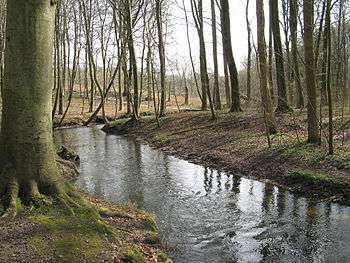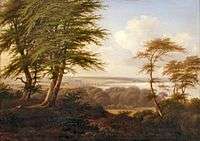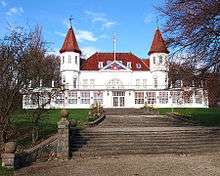Marselisborg Forests
| Marselisborg Forests (Marselisborgskovene) | |
| Marselisborg Forest | |
| Forest | |
 Part of Marselisborg Forests, showing the Giber stream running through Moesgård forest. | |
| Official name: Marselisborg Forests | |
| Country | Denmark |
|---|---|
| Region | Central Denmark Region |
| Municipality | Aarhus |
| Part of | Scandinavia |
| City | Aarhus |
| Building | Watermills, Pavilion, Manor, Outdoor museum, Restaurants, Hotel, Sportsclubs, Allotments, Camping, Stadium, Tivoli. |
| River | Varna stream, Giber Å plus several minor streams. |
| Area | 15 km2 (6 sq mi) |
| Biome | mixed deciduous forest, natural beech wood, temperate coniferous forest plus seventeen special habitats[1] |
| Wikimedia Commons: Marselisborg Forests | |
Marselisborg Forests (Danish: Marselisborgskovene) or simply Marselisborg Forest, is a 1,300 hectares (3,200 acres) forest to the south of Aarhus City in Denmark.
Many present day sources now includes the forest of Fløjstrup, as part of the Marselisborg Forests, upping the total area with another 200 hectares (490 acres).
Marselisborg Forests runs along the coastline of the Aarhus Bay in a hilly terrain with steep slopes and deep gullies, especially at the shoreline. There are many traces of prehistoric activities here and the landscape have been covered by woodlands for thousands of years.
History
Marselisborg Forests is comprised by a collection of small patches of woodland, that have been allowed to merge into a single entity, mainly after 1820. The woodland patches originally belonged to the barony of Marselis, residing at the now gone Marselisborg (meaning "Marselis-castle"), where Marselisborg Gymnasium is located today. Before 1820, there was an extensive forestry in the woods, so most of the trees are no more than 200 years old. Aarhus Municipality took ownership of the land and forests in 1896, when they acquired the Marselis estate.
Cultural importance

Marselisborg Forests have a long cultural history as a recreational area for Aarhus and its citizens and today it is among the most frequented forests in Denmark. The forests are used heavily[3] for a variety of purposes, such as kindergarten excursions, camping, mountainbiking, scouting activities and headquarters, horse trails, running events, celebrations, picnics and more everyday unorganized activities like strolling, mushroom hunting, surf fishing, etc.. The forestry business is rather limited today. Marselisborg Forests are home to several important facilities for the citizens of the Aarhus area, such as:
- An amusement park (Tivoli Friheden)
- A stadium and sports arena (Atletion)
- A forestry botanical garden
- Marselisborg Deer Park.
- The Varna Palace from 1909. Now 'Odd Fellow Palace Varna' since 1970.[4]
- A hotel. The Helnan Marselis Hotel.[5]
- Blommehaven Camping site.[6]
- Marselisborg Kayak Club (MKC) and headquarters.[7]
- Frederikshøj Kro. Originally the home of the forest keeper, but also known as a restaurant from around 1800. For many years it offered orchestral concerts in addition to the food and drinks. Now exclusively a highend restaurant, with attached conference halls.[8][9]
- 3 old watermills:
- Silistria. First mentioned in written sources in 1661 and with a long history as a grain mill, brewery, restaurant, etc., Silistria is now the headquarters of OK Pan Århus, Denmarks oldest orienteering club founded in 1946.[10]
- Thors Mølle (English: Thors Mill) from 1637, as the only remaining stamp mill of the original five at the Varna stream.[11] Initially a powder mill and with a history as a guesthouse and restaurant, tracing back to the 1700s. The modern day restaurant at Thors Mølle, were founded around the year 1900.[12]
- Skovmøllen (English: The Mill in the Forest) can be traced back to at least the year 1570, but extensively altered and rebuilt in 1852. Skovmøllen is Denmark’s only functioning undershot millstone (with an overshot water wheel) and it powers both a grain mill and a sawmill. Skovmøllen have worked as a restaurant and housed celebrations since the 1800s. The milling business was restarted in the year 2000, by a team of volunteers and guided tours are arranged regularly.[13][14]
- Moesgård Museum with surrounding open-air museums. Previously an old manor.
The many sources to the cultural history and recreational use of the Marselisborg Forests through the ages, suggests that the forests were used even more extensively in previous times, than today. In the early 1900s, it even housed a zoo, and two steamboats regularly transported citizens from the Aarhus harbour to various spots, just for recreational purposes. Many of the historic documents of the booming restaurants and scenes, reports dramatic drops in turnovers, when television was introduced in the 1950-60's.
As one of the more popular and noteworthy happenings of our time, the northern parts of Marselisborg Forests houses a Sculpture by the Sea event once every second year in June. The tradition was initiated by crown princess Mary and crown prince Frederik of Denmark in 2009, inspired by Australia; Mary's country of birth. The event called 'Sculpture by the Sea, Aarhus - Denmark' is financially and legally independent of 'Sculpture by the Sea Incorporated' though and it is being produced by the city of Aarhus in collaboration with ARoS Aarhus Artmuseum under the patronage of the crown prince couple. The first two exhibitions attracted an estimated half a million visitors each.[15]
-
A sculpture of Pan in the woods near the northern entrances.
-

The Varna Palace
-

Thors Mill
-

The sluice at Thors Mill.
-

The red painted wooden structures are characteristic for the forests.
-
.jpg)
A 25 km mountainbike track runs through the forests.
-

Skovmøllen, showing the waterwheel at work.
Flora and fauna
In spite of the high level of human activity, Marselisborg Forests does have an interesting flora and fauna and it is not impossible to find the peace and tranquillity, that one normally associates with wild nature. It is one of the few big forests in Denmark, that can present larger connected areas of natural beech wood. Most of the forest is a mixed deciduous forest, with species like beech, ash and maple as the most common. There are other areas dominated by conifer, and oak trees are mixed in throughout the forest.
At Moesgård Museum, sections of the forest have been raised about 40 years ago, to recreate various forest-types associated with different epochs since the last ice age. These sections includes ash, birch and alder swamps, linden, elm and oak woods. Mixed in is also the versatile hazel and forest apple.
Marselisborg Forests is home to very rich and varied fungi colonies, with several rare or threatened species. The forests is known for its Mycorrhiza, but also the rare and poisonous Satan's mushrooms, Amanita strobiliformis[16] and bleeding corals are to be found here. In some years, larger quantities of the edible porcino, trumpet of the dead and charcoal burner can be found, to mention a few examples.[17]
The forests supports a population of northern crested newts. They are common in Denmark, preferring the south-eastern parts of the country, and is thus not a Red List species, but their habitats are threatened on an international scale. Based partly on these facts, a larger part of Marselisborg Forests is to be protected under the EU Habitats Directive and have been designated as area H234.
-

Autumn brings out a variety of mushrooms.
-

Beech forests can be quite dark.
-
_2.jpg)
Autumn scene from a natural beech wood habitat in the forests.
-

The coastal slopes are quite steep and inaccessible in most places.
-

The forests runs along the Bay of Aarhus.
Sources
- Bernhardt Jensen og Peder Jensen: Marselisborgskovene Aarhus University publishing house 1974 (Danish)
- Lars Friis Olsen: Gennem skovene syd for Århus Klim 2011, ISBN 9788779558656. (Danish)
- The Coastal Route Aarhus Municipality. Map available. (Danish)
- Habitat area H234 Danish Nature Agency (2011) (Danish)
- Great Crested Newt (Triturus cristatus) Habitat species of Denmark. (Danish)
- Sculpture by the Sea, Aarhus The exhibitions own website
External links
- The Marselisborg Forests Aarhus Wiki. There is a map of the forest area, except the Fløjstrup Forest. (Danish)
- Paintings from Marselisborg Forests Den Gamle By
![]() Media related to Marselisborg Forests at Wikimedia Commons
Media related to Marselisborg Forests at Wikimedia Commons
Notes and references
- ↑ "Natura 2000-plan 2010-2015. Giber Å, Enemærket og Skåde Hav- bakker" (PDF) (in Danish). Danish Nature Agency. 1 December 2011. ISBN 978-87-7091-565-6. Retrieved 4 September 2014.
- ↑ Peter Holm was a painter and organist at the Church of Our Lady in Aarhus
- ↑ In a 2007 survey 21% of the questioned citizens said, that they used Marselisborg Forests more than once a month. Source:The citizens attitude towards open land and green area - In Aarhus and countrywide; p.7-9, EPINION (Aarhus Municipality) (Danish)
- ↑ Varna Palæet Official homepage in Danish.
- ↑ Helnan Marselis Hotel Helnan International Hotels. Official homepage in English
- ↑ DCU-Camping Blommehaven Danish Camping Union (DCU). Official homepage in English.
- ↑ Marselisborg Kajak Club Official homepage in Danish.
- ↑ Frederikshøj Kro Aarhus Wiki (06.10.13) (Danish)
- ↑ Frederikshøj the restaurants own homepage
- ↑ Orienteringsklubben Pan Århus Official homepage in Engish.
- ↑ There are five mill-spots along the Varna stream, but there have been a total of seven mills through the ages. In the old days the Varna stream was called Skambækken - Aarhus Wiki
- ↑ Information Restaurant Thors Mølle own website (Lars Morell) (06.10.13) (Danish)
- ↑ Skovmøllen - The Mill in the Forest Moesgård Museum
- ↑ Skovmøllen Official homepage of the restaurant in Danish.
- ↑ 3rd Biennial Aarhus Exhibition Sculpture by the Sea (2013)
- ↑ Amanita strobiliformis is called 'Flosset Fluesvamp' in Danish, meaning lit.: frayed fly-mushroom
- ↑ Mushrooms in Eastern Jutland private homepage (Flemming V. Larsen) (Danish)
Coordinates: 56°06′N 10°14′E / 56.100°N 10.233°E